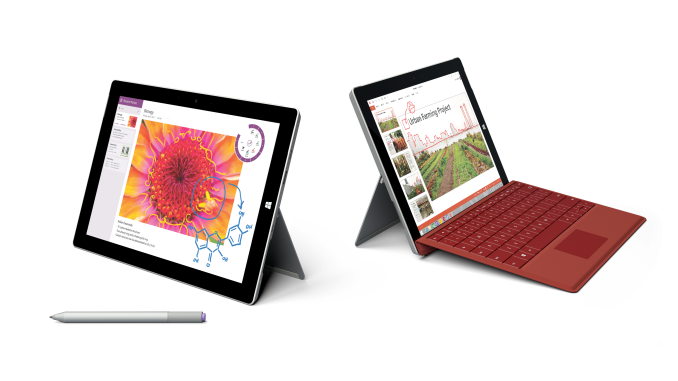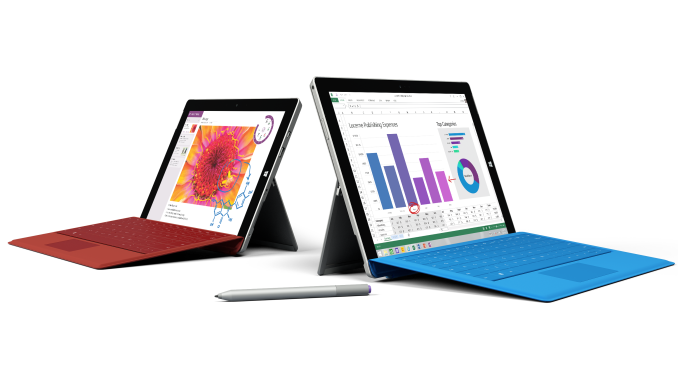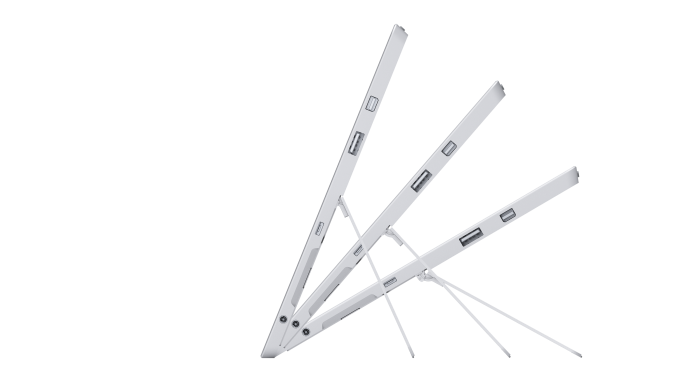Microsoft Announces Surface 3: 10.8-inch 2-in-1 with Atom x7 on 14nm from $499
by Ian Cutress on March 31, 2015 9:52 AM EST
The next element of Microsoft’s Surface line is here, and the anticipated Surface 3 throws up a couple of (nice) surprises. Starting at $499, the Surface 3 will complement the Surface Pro 3 by offering a 10.8-inch device in a 1920x1280 resolution. That sounds a little odd being a bit more than full-HD, but offers a 3:2 resolution like the larger Surface Pro 3. Under the hood is Intel’s new Atom x7 which we discussed briefly during the Atom re-naming launch earlier this year, which means a 14nm class device featuring Airmont cores and the direct upgrade from Silvermont and Bay Trail. The release states that this is the high end model, which would suggest a quad-core Atom design running above 2 GHz. Microsoft/Intel are not directly calling this Cherry Trail, and our discussions with Intel seem to avoid the Cherry Trail nomenclature, but the SoC will be partnered with 64GB or 128GB of storage, plus a 4G ‘LTE Ready’ version will be coming later.
The Surface 3 is being billed by Microsoft as the thinnest and lightest Surface device, and will run the full Windows 8.1 inside which can be upgraded to Windows 10 later this year for free. The price will include a 1-year subscription to Office 365, as well as 1TB of OneDrive storage. On the device will be a full-size USB 3.0 port, a mini-DisplayPort and a microSD card reader to supplement storage. Charging comes via a bundled fast-charging micro-USB, although it can also be charged with a standard smartphone micro-USB as well. Battery life is listed as 10 hours for video playback, with the screen being described as having ‘incredibly accurate colors’ – here’s hoping for a calibrated display out of the box. Front and rear cameras (3.5MP / 8MP) are designed to both capture 1080p, with an auto-focus feature on the rear camera.
The device on its own will be 8.7mm thin, weighing in at 622 grams (1.37 pounds), and seems to not feature the kickstand that Anand liked in his Surface Pro 3 review. Instead we get a standard 3-position stand. Accessories start with the standard Type Cover but also include a Docking Station with more USB ports as well as ‘The Surface Pen’. The new digital pen will be available in red, blue, black and silver with 256 levels of pressure sensitivity - we presume this is an N-Trig design although we’re waiting for official confirmation.
The Surface 3 and accessories are now available for pre-order in the US, shipping on May 5th. Resellers and partners should have availability on May 7th, although from 1st April users should be able to head into a Microsoft Store in Canada, Puerto Rico and the United States for some hands on time before full launch.
We’ve already put in our request for a review unit.
Source: Microsoft
| Microsoft Surface 3 | ||
| Size | 10.52 x 7.36 x 0.34-inch 267 x 187 x 8.7-mm |
|
| Weight | 1.37 lbs - 622 g | |
| Display | 10.8-inch ClearType Full HD Plus 1920x1280 resolution, 3:2 ratio 10-point multi-touch Surface Pen Support |
|
| Battery Life | Up to 10 hours (video playback) | |
| Storage/DRAM | 64GB / 2GB | 128GB / 4GB |
| CPU | Atom x7-Z8700 Quad Core 14nm 1.6 GHz Base Frequency 2.4 GHz Burst Frequency |
|
| WiFi | 802.11ac + BT 4.0 LTE Models at a later date |
|
| Ports | USB 3.0, Mini-DisplayPort, microSD, Micro USB charging, 3.5mm Headset Jack |
|
| Software | Windows 8.1 Office 365 Personal with 1TB OneDrive (1-year) |
|
| Front Camera | 3.5 MP | |
| Rear Camera | 8.0 MP with Autofocus | |
| Operating System | Windows 8.1 64-bit | |
| Warranty | 1-year limited | |
| Price | $499 | $599 |
Edit: This news post originally stated that the kickstand was the same as the Surface Pro 3. This error has been adjusted due to new information.



















121 Comments
View All Comments
Mobile-Dom - Tuesday, March 31, 2015 - link
do we know what type of storage it uses? eMMC? UFS? M.2 SSD?kyuu - Tuesday, March 31, 2015 - link
Almost certainly eMMC, like. Baytrail before it. Definitely not M.2.kyuu - Tuesday, March 31, 2015 - link
Here's the spec sheet on the Atom x7 (far right column) for reference: http://cdn.arstechnica.net/wp-content/uploads/2015...Samus - Tuesday, March 31, 2015 - link
$100+ for 64GB more storage? Who do they think they are, Apple?kyuu - Tuesday, March 31, 2015 - link
$100 for 64GB storage AND 2GB more RAM. Also, Apple charges $100 for 32GB don't they? Or even 16GB?Tegeril - Tuesday, March 31, 2015 - link
Apple's tiers are 16/64/128. So at worst, they charge $100 for 48GB.kyuu - Tuesday, March 31, 2015 - link
Actually, at worst they charge $50 for 16GB. That's with the previous Gen Air, granted, but they still sell it. And I think that's less than they charged when it was first released, though I could be misremembering.name99 - Tuesday, March 31, 2015 - link
Apple charges $100 for the jump from 64 to 128GB iPad. Your snark would be more effective if you restrained yourself to points that are actually true (ie that MS also throws in 2GB of RAM).To know whether these prices are comparable or not, we'd need to know something about the quality of flash in each case (eg the base speeds, the extent of over-provisioning, the energy per unit operation). These numbers certainly don't exist for iPads, and we don't yet know what they are for the Surface, so you don't really have anything to justify your complaints.
kyuu - Tuesday, March 31, 2015 - link
Thanks for the unnecessary hostility, first of all. No snark was present in my comment, contrary to your erroneous inference.Second, Apple charges $100 for the jump from 64GB to 128GB, sure. They also charge $100 to go from 16GB to 64GB, and $50 to go from 16GB to 32GB (with the 1st Gen Air). So they are rather inconsistent on how much they feel NAND is worth.
Regardless, the only point I was making was that complaining about the cost of the Surface 3 upgrade is a bit off base. No one in the tablet segment gives you more for $100, and most in fact give you a lot less.
Samus - Wednesday, April 1, 2015 - link
Damn name99 go over to dailytech with that attitude. What I was pointing out (and everyone else seemed to notice) is only Apple charges that much for the tier jump ($100) as Samsung, Motorola and pretty much any other manufacture of integrated computing charges at worst $79 between tiers (with $39-$50 being the most common.)The fact it comes with a whopping extra 2GB DDR3 is completely irrelevent because this isn't a PoP SoC, the capacity bump isn't in form factor real estate but simply a higher density chip (at a cost difference of a few dollars on the BOM.)
So my original point stands, the $100 price increase is sheer milking of the "high end" consumer and holding back the status quo into buying the more limited model, which inevitably holds back innovation (look at the iPhone and how iOS is still forced to run acceptably on 512MB RAM because Apple didn't bump the capacity for years.)